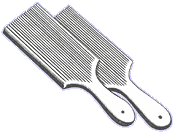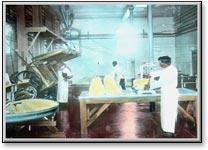If the butter is to be salted, salt (1-3%) is spread over its surface, in the case of batch production. At the ratio of 0 to 2 teaspoons per 500 grammes (or per pound). In the continuous buttermaker, a salt slurry is added to the butter . the salt is all dissolved is the aqueous phase, so the effective salt concentration is approximately 10% in the water.
After salting, the butter must be worked vigorously to ensure even distribution of the salt. The working of the butter also influences the characteristics by which the product is judged - aroma, taste, keeping quality, appearance and color. Working is required to obtain a homogenous blend of butter granules, water and salt. During working, fat moves from globular to free fat. Water droplets decrease in size during working and should not be visible in properly worked butter . Overworked butter will be too brittle or greasy depending on whether the fat is hard or soft. Some water may be added to standardize the moisture content.
 If being made by hand, with the wash water drained off, the butter grains mat together and can be removed from the churn then placed onto a wooden board. The board is sloped a little to aid remaining water to drain away. The butter is patted with the scotch hands (left) to press out the water. It is patted into a thin layer, folded over and then patted again, improving the texture.
If being made by hand, with the wash water drained off, the butter grains mat together and can be removed from the churn then placed onto a wooden board. The board is sloped a little to aid remaining water to drain away. The butter is patted with the scotch hands (left) to press out the water. It is patted into a thin layer, folded over and then patted again, improving the texture.

